How To Find Percent Saturation Dissolved Oxygen
Dissolved Oxygen
What is Dissolved Oxygen?
Dissolved oxygen refers to the level of free, non-compound oxygen present in water or other liquids. It is an of import parameter in assessing water quality because of its influence on the organisms living within a body of h2o. In limnology (the study of lakes), dissolved oxygen is an essential factor 2d only to h2o itself ¹. A dissolved oxygen level that is too high or too depression tin can harm aquatic life and affect water quality.
Non-compound oxygen, or gratuitous oxygen (O2), is oxygen that is not bonded to any other element. Dissolved oxygen is the presence of these complimentary O2 molecules within h2o.The bonded oxygen molecule in water (Water) is in a compound and does not count toward dissolved oxygen levels. One can imagine that free oxygen molecules dissolve in water much the mode table salt or sugar does when information technology is stirred ².
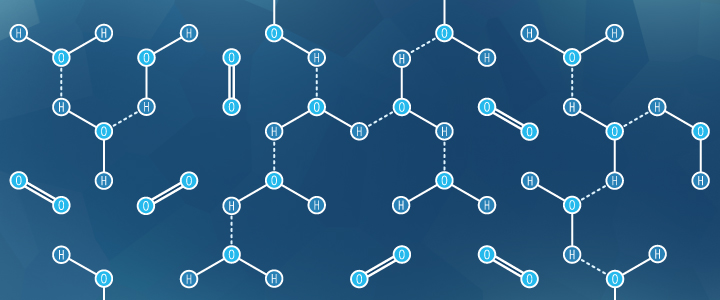
Dissolved Oxygen and Aquatic Life
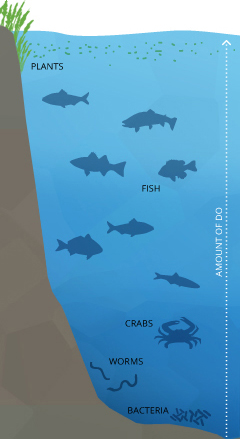
Dissolved oxygen is necessary to many forms of life including fish, invertebrates, bacteria and plants. These organisms utilise oxygen in respiration, like to organisms on land. Fish and crustaceans obtain oxygen for respiration through their gills, while plant life and phytoplankton crave dissolved oxygen for respiration when in that location is no lite for photosynthesis iv. The amount of dissolved oxygen needed varies from creature to brute. Lesser feeders, crabs, oysters and worms demand minimal amounts of oxygen (one-6 mg/50), while shallow h2o fish need college levels (iv-fifteen mg/L)⁵.
Microbes such as leaner and fungi too crave dissolved oxygen. These organisms use DO to decompose organic cloth at the lesser of a body of water. Microbial decomposition is an important contributor to nutrient recycling. However, if there is an excess of decaying organic cloth (from dying algae and other organisms), in a body of water with infrequent or no turnover (also known every bit stratification), the oxygen at lower water levels will get used up quicker ⁶.
Where Does DO Come From?
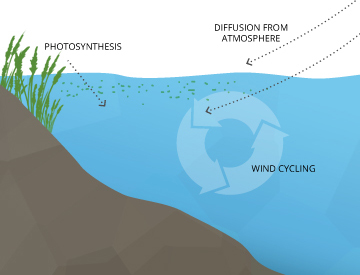
Dissolved oxygen enters h2o through the air or as a found byproduct. From the air, oxygen can slowly diffuse across the water's surface from the surrounding atmosphere, or be mixed in quickly through aeration, whether natural or man-fabricated vii. The aeration of water tin can be caused past air current (creating waves), rapids, waterfalls, ground water discharge or other forms of running h2o. Man-made causes of aeration vary from an aquarium air pump to a mitt-turned waterwheel to a large dam.
Dissolved oxygen is too produced equally a waste production of photosynthesis from phytoplankton, algae, seaweed and other aquatic plants viii.
Dissolved Oxygen from Photosynthesis
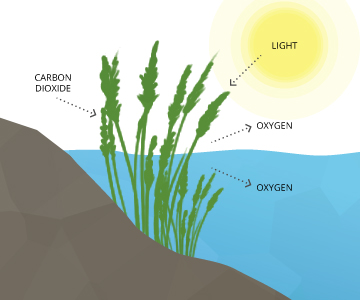
While most photosynthesis takes place at the surface (past shallow h2o plants and algae), a large portion of the procedure takes identify underwater (by seaweed, sub-surface algae and phytoplankton). Light can penetrate water, though the depth that information technology tin accomplish varies due to dissolved solids and other low-cal-scattering elements present in the h2o. Depth also affects the wavelengths available to plants, with red being absorbed quickly and blue light existence visible past 100 m. In clear water, at that place is no longer plenty calorie-free for photosynthesis to occur beyond 200 g, and aquatic plants no longer grow. In turbid water, this photic (light-penetrating) zone is frequently much shallower.
Regardless of wavelengths available, the bicycle doesn't modify ⁹. In addition to the needed light, CO2 is readily absorbed by water (it's virtually 200 times more soluble than oxygen) and the oxygen produced as a byproduct remains dissolved in water¹⁰. The basic reaction of aquatic photosynthesis remains:
CO2 + H2O → (CH2O) + O2
As aquatic photosynthesis is light-dependent, the dissolved oxygen produced will peak during daylight hours and decline at night ⁸.
Dissolved Oxygen Saturation
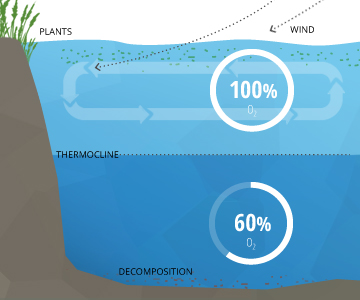
In a stable torso of h2o with no stratification, dissolved oxygen volition remain at 100% air saturation. 100% air saturation means that the water is property every bit many dissolved gas molecules every bit it can in equilibrium. At equilibrium, the percentage of each gas in the h2o would exist equivalent to the percentage of that gas in the atmosphere – i.e. its fractional pressure ¹³. The water will slowly absorb oxygen and other gasses from the atmosphere until information technology reaches equilibrium at complete saturation 10. This process is sped up by air current-driven waves and other sources of aeration ³.
In deeper waters, Exercise can remain beneath 100% due to the respiration of aquatic organisms and microbial decomposition. These deeper levels of water often exercise not reach 100% air saturation equilibrium because they are not shallow enough to be affected by the waves and photosynthesis at the surface ³. This h2o is beneath an invisible purlieus called the thermocline (the depth at which water temperature begins to pass up)¹¹.
What Affects Oxygen Solubility?
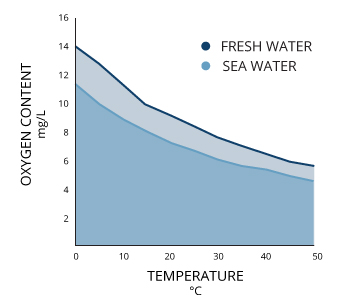
Two bodies of water that are both 100% air-saturated practise not necessarily have the same concentration of dissolved oxygen. The actual corporeality of dissolved oxygen (in mg/Fifty) will vary depending on temperature, pressure and salinity ¹.
Offset, the solubility of oxygen decreases as temperature increases ¹. This means that warmer surface h2o requires less dissolved oxygen to reach 100% air saturation than does deeper, cooler water. For case, at ocean level (1 atm or 760 mmHg) and 4°C (39°F), 100% air-saturated water would hold ten.92 mg/50 of dissolved oxygen. ³ Merely if the temperature were raised to room temperature, 21°C (70°F), in that location would only exist 8.68 mg/L Practice at 100% air saturation ³.
2nd dissolved oxygen decreases exponentially as common salt levels increase ¹. That is why, at the aforementioned pressure level and temperature, saltwater holds well-nigh twenty% less dissolved oxygen than freshwater ³.
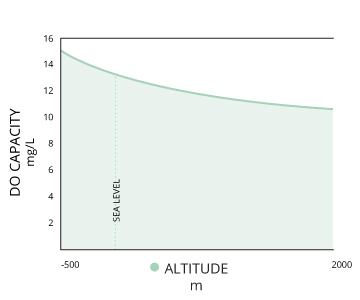
3rd, dissolved oxygen will increase as pressure increases ¹. This is truthful of both atmospheric and hydrostatic pressures. Water at lower altitudes can hold more dissolved oxygen than water at higher altitudes. This human relationship also explains the potential for "supersaturation" of waters beneath the thermocline – at greater hydrostatic pressures, water can agree more than dissolved oxygen without it escaping ¹. Gas saturation decreases by 10% per meter increment in depth due to hydrostatic pressure ¹². This means that if the concentration of dissolved oxygen is at 100% air saturation at the surface, information technology would just be at 70% air saturation three meters below the surface.
In summary, colder, deeper fresh waters take the capability to hold higher concentrations of dissolved oxygen, but due to microbial decomposition, lack of atmospheric contact for improvidence and the absence of photosynthesis, bodily DO levels are oftentimes far below 100% saturation ¹⁰. Warm, shallow saltwater reaches 100% air saturation at a lower concentration, merely tin can often achieve levels over 100% due to photosynthesis and aeration. Shallow waters too remain closer to 100% saturation due to atmospheric contact and constant diffusion ¹⁰.
If there is a significant occurrence of photosynthesis or a rapid temperature change, the water tin attain DO levels over 100% air saturation. At these levels, the dissolved oxygen volition dissipate into the surrounding water and air until it levels out at 100% ³.
How Can Water exist More than 100% Saturated?
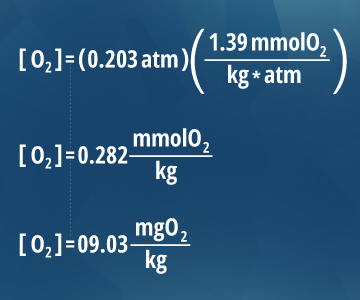
100% air saturation is the equilibrium point for gases in water. This is because gas molecules diffuse between the temper and the water'southward surface. According to Henry's Police force, the dissolved oxygen content of water is proportional to the pct of oxygen (partial pressure level) in the air above it thirteen. As oxygen in the temper is about twenty.three%, the partial pressure of oxygen at sea level (1 atm) is 0.203 atm. Thus the amount of dissolved oxygen at 100% saturation at sea level at xx° C is ix.03 mg/L ¹⁰.
The equation shows that water volition remain at 100% air saturation at equilibrium. Yet, there are several factors that can affect this. Aquatic respiration and decomposition lower Practice concentrations, while rapid aeration and photosynthesis tin can contribute to supersaturation. During the process of photosynthesis, oxygen is produced as a waste. This adds to the dissolved oxygen concentration in the h2o, potentially bringing it in a higher place 100% saturation ¹⁴. In addition, the equalization of water is a wearisome process (except in highly agitated or aerated situations). This means that dissolved oxygen levels can easily be more 100% air saturation during the day in photosynthetically active bodies of water ¹⁴.
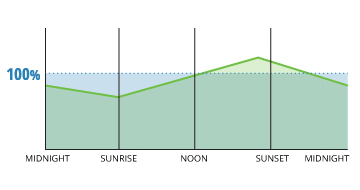
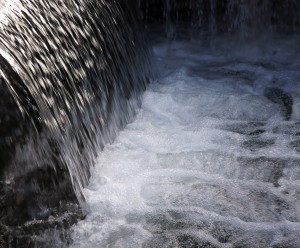
Supersaturation caused past rapid aeration is ofttimes seen beside hydro-ability dams and big waterfalls ¹². Dissimilar small rapids and waves, the water flowing over a dam or waterfall traps and carries air with it, which is and then plunged into the water. At greater depths and thus greater hydrostatic pressures, this entrained air is forced into solution, potentially raising saturation levels over 100% ¹².
Rapid temperature changes tin can also create Exercise readings greater than 100% ¹⁴. As water temperature rises, oxygen solubility decreases. On a cool summer night, a lake's temperature might be 60° F. At 100% air saturation, this lake's dissolved oxygen levels would exist at 9.66 mg/Fifty. When the dominicus rises and warms up the lake to 70° F, 100% air saturation should equate to 8.68 mg/L DO ³. Merely if there is no wind to motion the equilibration along, the lake will nonetheless contain that initial nine.66 mg/Fifty Exercise, an air saturation of 111%.
Typical Dissolved Oxygen Levels
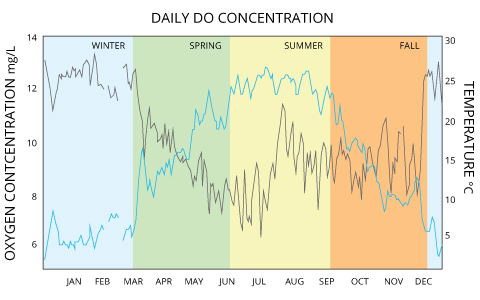
Dissolved oxygen concentrations are constantly affected past improvidence and aeration, photosynthesis, respiration and decomposition. While h2o equilibrates toward 100% air saturation, dissolved oxygen levels will likewise fluctuate with temperature, salinity and force per unit area changes ³. As such, dissolved oxygen levels can range from less than i mg/L to more than twenty mg/L depending on how all of these factors interact. In freshwater systems such as lakes, rivers and streams, dissolved oxygen concentrations will vary by flavor, location and water depth.
Freshwater Fluctuations: Example 1
In the Pompton River in New Jersey, mean dissolved oxygen concentrations range from 12-thirteen mg/L in winter and driblet to 6-ix mg/L in the summer ⁸. That same river shows daily fluctuations of upwards to 3 mg/L due to photosynthesis production ⁸.
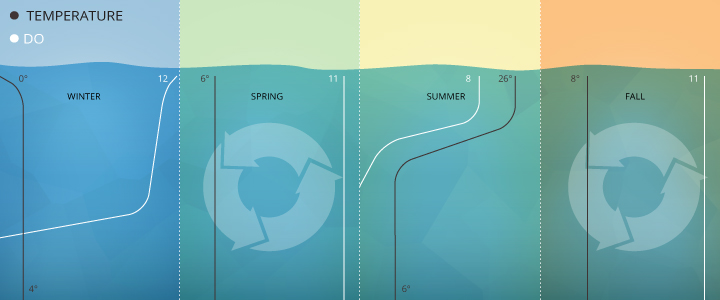
Freshwater Fluctuations: Example two
Studies at Crooked Lake in Indiana show dissolved oxygen concentrations vary past season and depth from 12 mg/L (surface, winter) to 0 mg/L (32 1000 depth, late summer), with full lake turnovers in spring and fall equalizing Do levels around 11 mg/L for all depths ¹.
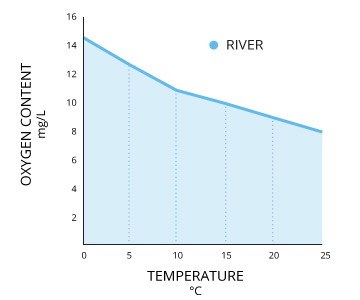
Rivers and streams tend to stay near or slightly above 100% air saturation due to relatively large surface areas, aeration from rapids, and groundwater discharge, which means that their dissolved oxygen concentrations will depend on the h2o temperature ¹. While groundwater normally has depression DO levels, groundwater-fed streams can hold more oxygen due to the influx of colder water and the mixing information technology causes ¹⁵. Standard Methods for the Examination of H2o and Wastewater defines dissolved oxygen in streams as the sum of photosynthetic byproducts, respiration, re-aeration, accrual from groundwater inflow and surface runoff ¹³.
Saltwater holds less oxygen than freshwater, then oceanic DO concentrations tend to be lower than those of freshwater. In the ocean, surface h2o mean annual Exercise concentrations range from 9 mg/Fifty most the poles down to four mg/L virtually the equator with lower Practice levels at further depths. In that location are lower dissolved oxygen concentrations near the equator considering salinity is higher ¹⁶.
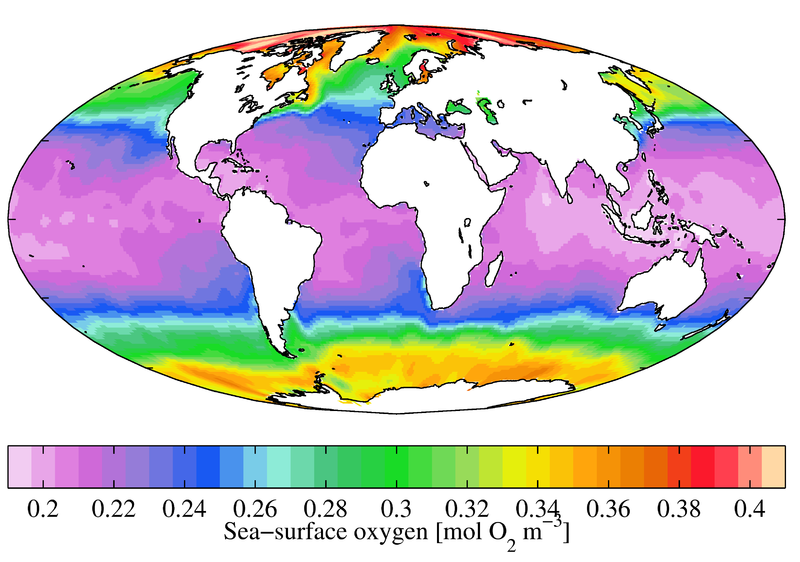
Some states have Water Quality Standard Acts, requiring minimum concentrations of dissolved oxygen; in Michigan, these minimums are 7 mg/50 for cold-water fisheries and 5 mg/L for warm-h2o fish 17; in Colorado, "Class one Cold Water Aquatic Life" needs 6 mg/L, and "Class ane Warm H2o Aquatic Life" requires Exercise levels of at to the lowest degree five mg/L 15. In social club to mimic ideal environmental systems, freshwater tanks ideally need around 8 mg/L Practise for optimum growth and marine tank requirements range from 6-vii mg/L Practise based on the salinity level ¹⁸. In other words, dissolved oxygen should be near 100% air saturation.
Examples of Freshwater Organisms and Dissolved Oxygen Requirements
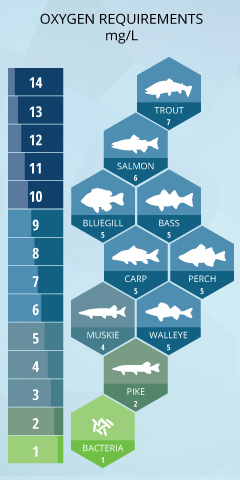
Coldwater fish like trout and salmon are virtually affected by low dissolved oxygen levels nineteen. The mean DO level for adult salmonids is 6.v mg/L, and the minimum is 4 mg/50 ¹². These fish mostly endeavour to avert areas where dissolved oxygen is less than five mg/L and volition begin to die if exposed to Practise levels less than three mg/L for more than a couple days ¹⁹. For salmon and trout eggs, dissolved oxygen levels below 11 mg/L volition delay their hatching, and below eight mg/L volition impair their growth and lower their survival rates. ¹⁹ When dissolved oxygen falls below 6 mg/L (considered normal for most other fish), the vast majority of trout and salmon eggs will die. ¹⁹
Bluegill, Largemouth Bass, White Perch, and Xanthous Perch are considered warmwater fish and depend on dissolved oxygen levels above v mg/L21. They volition avoid areas where DO levels are beneath 3 mg/L, simply generally practice not begin to suffer fatalities due to oxygen depletion until levels fall below two mg/L 22. The hateful Exercise levels should remain about 5.5 mg/Fifty for optimum growth and survival ¹².
Walleye also adopt levels over five mg/L, though they tin can survive at 2 mg/50 Practise levels for a short time.²⁴ Muskie need levels over 3 mg/50 for both adults and eggs ²⁵. Bother are hardier, and while they tin can enjoy dissolved oxygen levels above 5 mg/50, they easily tolerate levels beneath 2 mg/Fifty and can survive at levels below 1 mg/50 ²⁶.
The freshwater fish most tolerant to DO levels include fathead minnows and northern freeway. Northern pike tin can survive at dissolved oxygen concentrations equally low as 0.ane mg/L for several days, and at one.v mg/L for an infinite amount of time ²⁷. Fathead minnows can survive at ane mg/L for an extended menstruation with only minimal furnishings on reproduction and growth.
As for bottom-dwelling microbes, Do changes don't bother them much. If all the oxygen at their water level gets used up, bacteria will start using nitrate to decompose organic matter, a process known as denitrification. If all of the nitrogen is spent, they will begin reducing sulfate ¹⁷. If organic thing accumulates faster than it decomposes, sediment at the bottom of a lake just becomes enriched by the organic material. ²⁸.
Examples of Saltwater Organisms and Dissolved Oxygen Requirements
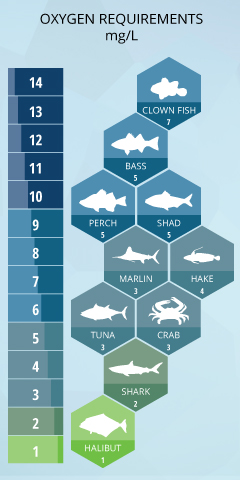
Saltwater fish and organisms have a higher tolerance for low dissolved oxygen concentrations every bit saltwater has a lower 100% air saturation than freshwater. In general, dissolved oxygen levels are about twenty% less in seawater than in freshwater ³.
This does not mean that saltwater fish can live without dissolved oxygen completely. Striped bass, white perch and American shad demand Practise levels over 5 mg/L to grow and thrive ⁵. The red hake is also extremely sensitive to dissolved oxygen levels, abandoning its preferred habitat near the seafloor if concentrations fall below 4.2 mg/L ²⁹.
The dissolved oxygen requirements of open up-ocean and deep-ocean fish are a chip harder to runway, but at that place have been some studies in the area. Billfish swim in areas with a minimum of 3.v mg/L Practice, while marlins and sailfish volition swoop to depths with Do concentrations of 1.v mg/L ³⁰. Likewise, white sharks are also limited in dive depths due to dissolved oxygen levels (in a higher place 1.5 mg/Fifty), though many other sharks have been found in areas of low DO ³³. Tracked swordfish bear witness a preference for shallow water during the twenty-four hour period, basking in oxygenated water (seven.7 mg/Fifty) after diving to depths with concentrations effectually 2.v mg/L ³⁴. Albacore tuna alive in mid-ocean levels, and require a minimum of 2.5 mg/L ³⁵, while halibut can maintain a minimum DO tolerance threshold of 1 mg/L ³⁶.
Many tropical saltwater fish, including clown fish, angel fish and groupers require college levels of DO, such equally those surrounding coral reefs. Coral reefs are establish in the euphotic zone (where low-cal penetrates the water – usually not deeper than 70 one thousand). Higher dissolved oxygen concentrations are generally found effectually coral reefs due to photosynthesis and aeration from eddies and breaking waves ³⁷. These Do levels tin can fluctuate from 4-15 mg/Fifty, though they commonly remain effectually v-8 mg/Fifty, cycling between day photosynthesis production and night plant respiration ³⁸. In terms of air saturation, this means that dissolved oxygen almost coral reefs can easily range from 40-200% ³⁹.
Crustaceans such as venereal and lobsters are benthic (bottom-dwelling) organisms, but still require minimum levels of dissolved oxygen. Depending on the species, minimum DO requirements tin range from 4 mg/Fifty to ane mg/L ¹³. Despite being bottom dwellers, mussels, oysters and clams also require a minimum of 1-2 mg/L of dissolved oxygen 29, which is why they are found in shallower, coastal waters that receive oxygen from the temper and photosynthetic sources.
Consequences of Unusual Exercise Levels
If dissolved oxygen concentrations drop below a certain level, fish bloodshed rates will rising. Sensitive freshwater fish similar salmon tin can't fifty-fifty reproduce at levels beneath 6 mg/Fifty ¹⁹. In the ocean, coastal fish begin to avert areas where Do is below 3.7 mg/L, with specific species abandoning an expanse completely when levels autumn below iii.5 mg/Fifty ²⁹. Beneath 2.0 mg/50, invertebrates also leave and below 1 mg/L even benthic organisms testify reduced growth and survival rates ²⁹.
Fish kill / Winterkill
A fishkill occurs when a big number of fish in an expanse of water dice off. It can be species-based or a water-broad bloodshed. Fish kills can occur for a number of reasons, simply low dissolved oxygen is often a factor. A winterkill is a fish kill caused past prolonged reduction in dissolved oxygen due to water ice or snowfall cover on a lake or pond ²⁰.
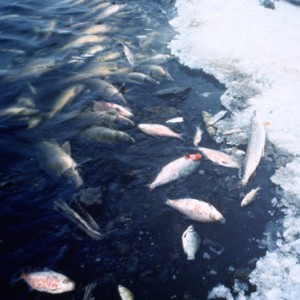
When a torso of h2o is overproductive, the oxygen in the water may become used up faster than information technology can exist replenished. This occurs when a torso of water is overstocked with organisms or if there is a big algal bloom dice-off.
Fish kills are more common in eutrophic lakes: lakes with high concentrations of nutrients (especially phosphorus and nitrogen) ⁴¹. High levels of nutrients fuel algae blooms, which can initially boost dissolved oxygen levels. Simply more algae means more found respiration, drawing on Exercise, and when the algae die, bacterial decomposition spikes, using up about or all of the dissolved oxygen available. This creates an anoxic, or oxygen-depleted, environment where fish and other organisms cannot survive. Such nutrient levels can occur naturally, simply are more than often caused by pollution from fertilizer runoff or poorly treated wastewater ⁴¹.
Winterkills occur when respiration from fish, plants and other organisms is greater than the oxygen product by photosynthesis ¹. They occur when the h2o is covered past water ice, and then cannot receive oxygen by diffusion from the atmosphere. If the ice is and then covered by snowfall, photosynthesis besides cannot occur, and the algae will depend entirely on respiration or die off. In these situations, fish, plants and decomposition are all using up the dissolved oxygen, and it cannot be replenished, resulting in a winter fish impale. The shallower the water, and the more productive (high levels of organisms) the water, the greater the likelihood of a winterkill ²⁰.
Gas Bubble Affliction
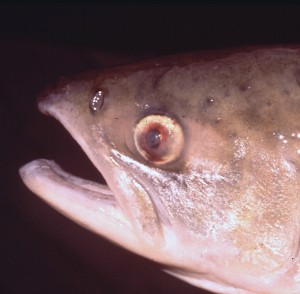
Just as depression dissolved oxygen can cause problems, so besides tin can loftier concentrations. Supersaturated water can cause gas bubble disease in fish and invertebrates ¹². Significant expiry rates occur when dissolved oxygen remains higher up 115%-120% air saturation for a period of time. Total mortality occurs in immature salmon and trout in under three days at 120% dissolved oxygen saturation ¹². Invertebrates, while also affected by gas bubble affliction, tin can usually tolerate higher levels of supersaturation than fish ¹².
Extended periods of supersaturation can occur in highly aerated waters, often near hydropower dams and waterfalls, or due to excessive photosynthetic activity. Algae blooms can cause air saturations of over 100% due to big amounts of oxygen as a photosynthetic byproduct. This is oft coupled with higher h2o temperatures, which as well affects saturation. ¹² At college temperatures, water becomes 100% saturated at lower concentrations, and so higher dissolved oxygen concentrations hateful even college air saturation levels.
Dead Zones
A dead zone is an area of water with little to no dissolved oxygen present. They are and so named considering aquatic organisms cannot survive there. Dead zones frequently occur near heavy human populations, such as estuaries and littoral areas off the Gulf of United mexican states, the North Sea, the Baltic Sea, and the E People's republic of china Body of water. They tin can occur in large lakes and rivers equally well, but are more well known in the oceanic context.
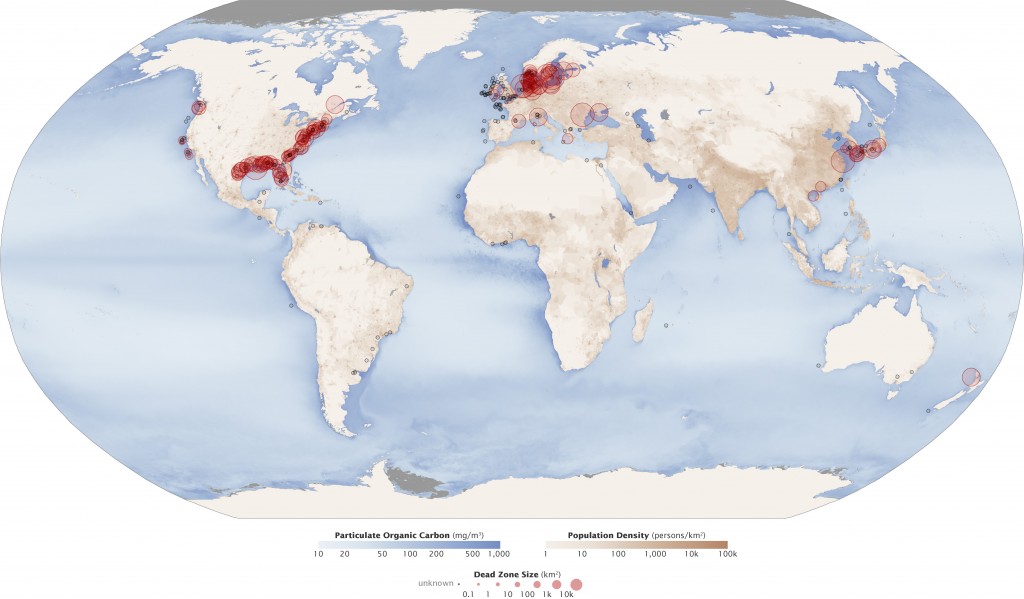
These zones are normally a upshot of a fertilizer-fueled algae and phytoplankton growth boom. When the algae and phytoplankton die, the microbes at the seafloor employ up the oxygen decomposing the organic matter ³¹. These anoxic conditions are ordinarily stratified, occurring just in the lower layers of the h2o. While some fish and other organisms tin can escape, shellfish, young fish and eggs ordinarily die ³².
Naturally occurring hypoxic (low oxygen) conditions are not considered expressionless zones. The local aquatic life (including benthic organisms) have adjusted to the recurring low-oxygen conditions, so the adverse effects of a dead zone (mass fish kills, sudden disappearance of aquatic organisms, and growth/development problems in fish and invertebrates) practice not occur ³¹.
Such naturally occurring zones oftentimes occur in deep lake basins and lower ocean levels due to water column stratification.
Dissolved Oxygen and Water Column Stratification
Stratification separates a body of water into layers. This layering tin be based on temperature or dissolved substances (namely salt and oxygen) with both factors oft playing a role. The stratification of water has been commonly studied in lakes, though information technology likewise occurs in the bounding main. It tin also occur in rivers if pools are deep plenty and in estuaries where at that place is a significant division betwixt freshwater and saltwater sources.
Lake Stratification
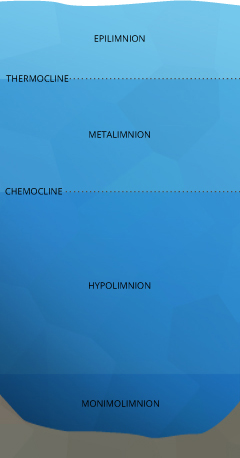
The uppermost layer of a lake, known as the epilimnion, is exposed to solar radiation and contact with the atmosphere, keeping it warmer. The depth of the epilimnion is dependent on the temperature substitution, usually adamant by h2o clarity and depth of mixing (usually initiated by wind) ¹¹. Inside this upper layer, algae and phytoplankton engage in photosynthesis. Between the contact with the air, potential for aeration and the byproducts of photosynthesis, dissolved oxygen in the epilimnion remains near 100% saturation. The verbal levels of DO vary depending on the temperature of the h2o, the amount of photosynthesis occurring and the quantity of dissolved oxygen used for respiration by aquatic life.
Beneath the epilimnion is the metalimnion, a transitional layer that fluctuates in thickness and temperature. The boundary between the epilimnion and metalimnion is called the thermocline – the point at which water temperature begins to steadily drop off ¹¹. Here, two different outcomes tin occur. If low-cal can penetrate across the thermocline and photosynthesis occurs in this strata, the metalimnion tin can attain an oxygen maximum ¹¹. This means that the dissolved oxygen level will be higher in the metalimnion than in the epilimnion. But in eutrophic or nutrient-rich lakes, the respiration of organisms can deplete dissolved oxygen levels, creating a metalimnetic oxygen minimum ⁴².
The next layer is the hypolimnion. If the hypolimnion is deep enough to never mix with the upper layers, it is known as the monimolimnion. The hypolimnion is separated from the upper layers by the chemocline or halocline. These clines marking the boundary between oxic and anoxic water and salinity gradients, respectively. ¹¹. While lab conditions would conclude that at colder temperatures and higher pressures water can hold more dissolved oxygen, this is not always the result. In the hypolimnion, bacteria and fungi use dissolved oxygen to decompose organic material ⁶. This organic material comes from expressionless algae and other organisms that sink to the lesser. The dissolved oxygen used in decomposition is not replaced – there is no atmospheric contact, aeration or photosynthesis to restore Exercise levels in the hypolimnion ¹¹. Thus the process of decomposition "uses up" all of the oxygen within this layer.
If the lake in question is a holomictic "mixing" lake, all the layers mix at to the lowest degree once per yr (usually jump and fall) when lake strata temperatures align. This turnover redistributes dissolved oxygen throughout all the layers and the procedure begins again.
Ocean Stratification
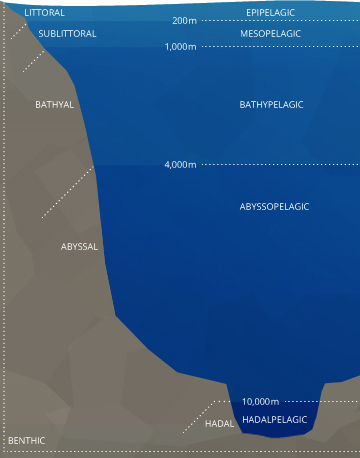
Stratification in the ocean is both horizontal and vertical. The littoral, or coastal area is nearly afflicted past estuaries and other inflow sources.⁴⁴ It tends to be shallow and tidal with fluctuating dissolved oxygen levels. The sublittoral, as well known as the neritic or demersal zone, is considered a coastal zone besides. In this zone, dissolved oxygen concentrations may vary but they exercise not fluctuate as much equally they practice in the coastal zone.
This is the zone where many coral reefs grow, and DO levels remain near 100% air saturation due to eddies, breaking waves and photosynthesis 45. This zone is also where nigh oceanic benthic (bottom-dwelling) organisms exist. Oceanic benthic fish do non live at the greatest depths of the ocean. They dwell at the seafloor near to coasts and oceanic shelves while remaining in the upper levels of the sea.
Beyond the demersal zone are the bathyal, abyssal and hadal plains, which are fairly like in terms of consistently low DO.
In the open ocean, there are five major vertical strata: epipelagic, mesopelagic, bathypelagic, abyssopelagic, and hadalpelagic ⁴⁴. The exact definitions and depths are subjective, simply the following information is generally agreed upon. The epipelagic is also known as the surface layer or photic zone (where low-cal penetrates). This is the layer with the highest levels of dissolved oxygen due to wave activeness and photosynthesis. The epipelagic mostly reaches to 200 thousand and is bordered by a collection of clines.
These clines can overlap or be at separate depths. Much similar in a lake, the thermocline divides oceanic strata past temperature. The halocline divides by salinity levels and the pycnocline divides strata by density ¹⁶. Each of these clines can impact the corporeality of dissolved oxygen the body of water strata can hold.
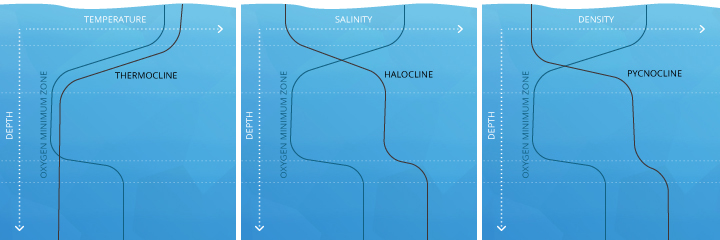
The mesopelagic, pregnant "twilight" zone, stretches from 200-yard m. Depending on h2o clarity, some lite may filter through, but in that location is not enough for photosynthesis to occur ⁴⁴. Within this strata, the oxygen minimum zone (OMZ) tin can occur. The OMZ develops considering organisms utilise the oxygen for respiration, but it is too deep to be replenished by photosynthetic oxygen byproducts or aeration from waves. This zone tends to exist effectually a depth of 500 m ⁴⁵. The mesopelagic zone is bordered by chemoclines (clines based on chemical science levels, e.g. oxygen and salinity) on both sides, reflecting different dissolved oxygen and salinity levels between the strata.
Beneath the mesopelagic is the aphotic zone(south). These strata have lower dissolved oxygen levels than the surface water because photosynthesis does not occur but tin can take higher levels than the OMZ because less respiration occurs.
The bathypelagic, "midnight" zone exists between thou-4000 thou, and many creatures tin can nevertheless live hither. The bottom layer of the bounding main is the abyssopelagic, which exists beneath 4000 thousand. The hadopelagic is the proper noun for the zone of deep ocean trenches that open below the abyssal patently, such as the Mariana Trench ⁴⁴.
Estuary Stratification
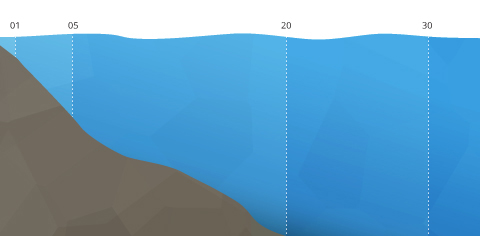
Estuary stratifications are based on salinity distributions. Considering saltwater holds less dissolved oxygen than freshwater, this tin can impact aquatic organism distribution. The stronger the river menses, the higher the oxygen concentrations. This stratification tin be horizontal, with Practice levels dropping from inland to open sea, or vertical, with the fresh, oxygenated river water floating over the low Practise seawater ⁴⁶. When the stratification is clearly defined, a pycnocline divides the fresher water from the salt h2o, contributing to separate dissolved oxygen concentrations in each strata.
Dissolved Oxygen Units and Reporting
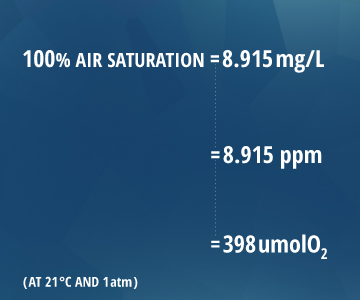
Dissolved oxygen is usually reported in milligrams per liter (mg/L) or as a percent of air saturation. Nonetheless, some studies will report Practise in parts per million (ppm) or in micromoles (umol). 1 mg/L is equal to 1 ppm. The relationship between mg/L and % air saturation has been discussed to a higher place, and varies with temperature, pressure and salinity of the h2o. One micromole of oxygen is equal to 0.022391 milligrams, and this unit is commonly used in oceanic studies ⁴⁷. Thus 100 umol/L O2 is equal to 2.2 mg/L O2.
Calculating DO from % Air Saturation
To calculate dissolved oxygen concentrations from air saturation, it is necessary to know the temperature and salinity of the sample. Barometric pressure has already been accounted for as the partial force per unit area of oxygen contributes to the percentage air saturation 7. Salinity and temperature tin can then exist used in Henry'due south Law to calculate what the DO concentration would be at 100% air saturation 10. However, information technology is easier to use an oxygen solubility chart. These charts show the dissolved oxygen concentration at 100% air saturation at varying temperatures, and salinities. This value can so be multiplied by the measured percent air saturation to calculate the dissolved oxygen concentration 7.
O2 mg/L = (Measured % Exercise)*(DO value from nautical chart at temperature and salinity)
Example:
70% DO measured
35 ppt salinity
15°C
.70 * 8.135 = v.69 mg/L Practise
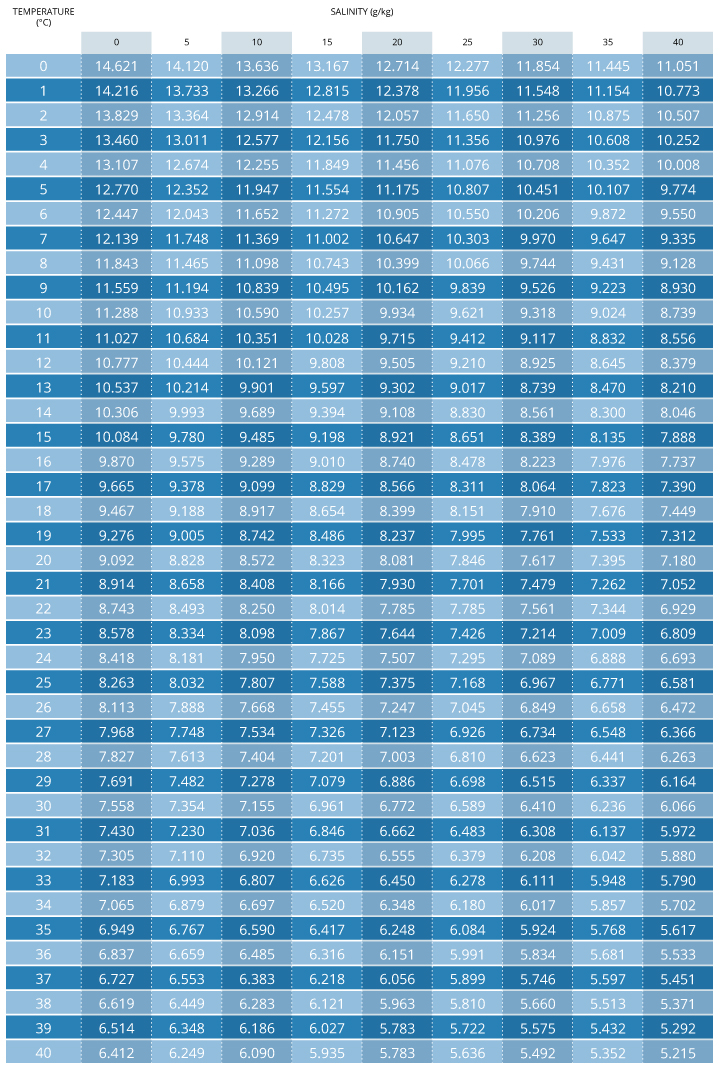
Cite This Work
Fondriest Ecology, Inc. "Dissolved Oxygen." Fundamentals of Environmental Measurements. 19 Nov. 2013. Spider web. < https://www.fondriest.com/environmental-measurements/parameters/water-quality/dissolved-oxygen/ >.
Additional Data
- Dissolved Oxygen Measurement Methods
- Dissolved Oxygen Sensors
- Dissolved Oxygen Meters
- Applications
- References
Source: https://www.fondriest.com/environmental-measurements/parameters/water-quality/dissolved-oxygen/
Posted by: brownnectur.blogspot.com


0 Response to "How To Find Percent Saturation Dissolved Oxygen"
Post a Comment